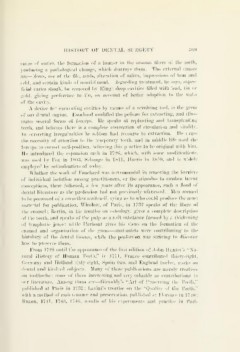Page 409 - My FlipBook
P. 409
TIIS'I'ORY OF DENTAL SURGERY 369 :
cause of caries, the formation of a Inuiior in the osseous fibers of the teeth,
producing a pathological change, which destroys them. The external causes
ai-e—blows, use of the tile, acids, alteration of saliva, impressions of heat and
cold, and certain kinds of nourishment. Regarding treatment, he says, super-
ficial caries should be removed by filing ; deep cavities filled with lead, tin or
uold, giving preference to tin, on account of better adaption to the walls
of the cavity.
A device for excavating cavities by means of a revolving tool, is the germ
of our dental engine. Fauchard modified the pelican for extracting, and illus-
trates several forms of forceps. He speaks of replanting and transplanting
teeth, and believes there is a complete restoration of circulation and vitality.
Jn connecting irregularities he seldom had recourse to extraction. He urges
The necessity of attention to the temporary teeth, and in middle life used the
forceps to correct nial-position, believing this practice to be original with him.
He introduced the expansion arch in 172C, which, with some modifications,
was used by Fox in 1803, Schange in li^-tl, Harris in 18.-)0, and is widely
employed by orthodontists of today.
Whether tlie work of Fauchard was instrumental in removing the Itarriers
of individual isolation among practitioners, or the stimulus to awaken latent
conceptions, there followed, a few years after its appearance, such a flood of
dental literature as the profession had not previously witnessed. Men seemed
to be possessed of a cacoethes scrihciidi. vying as to who could produce the most
material for publication. Winslow, of Paris, in 1732 speaks of the fibers of
the enamel; Bertin, in his treatise on osteology, gives a complete description
of the teeth, and speaks of the pulp as a soft substance formed by a thickening
of lymphatic juice: while Herisant gives his views on the formation of the
enamel and organization of the gums—anatomists were contributing to the
histology of the dental tissues, while the profession was striving to disco\cr
how to preserve them.
From 1728 until the appearance of the first edition of John Hunter's "Na-
tural History of Human Teeth," in 1771, France contributed thirty-eight,
Germany and Holland sixty-eight, Spain two, and England twelve, works on
dental and kindred sul)jects. Many of these pui)lications are merelv treatises
on toothache ; some of them interesting and very valuable as contributions to
our literature. Among them are—Girauldy's "Art of Preserving the Teeth,"
]ud)lished at Paris in 1737: Lavini's treatise on the "Quality of the Teeth,"
with a method of maintenance and preservation, published at Florence in 1740
Bunon, 1741. 1743, 1746, results of his experiments and practice in Paris


